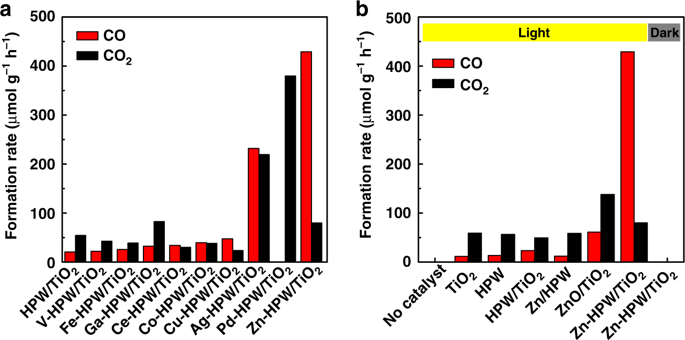当前位置:
X-MOL 学术
›
Nat. Commun.
›
论文详情
Our official English website, www.x-mol.net, welcomes your
feedback! (Note: you will need to create a separate account there.)
Selective photocatalytic conversion of methane into carbon monoxide over zinc-heteropolyacid-titania nanocomposites.
Nature Communications ( IF 14.7 ) Pub Date : 2019-02-11 , DOI: 10.1038/s41467-019-08525-2 Xiang Yu 1 , Vincent De Waele 2 , Axel Löfberg 1 , Vitaly Ordomsky 1, 3 , Andrei Y Khodakov 1
Nature Communications ( IF 14.7 ) Pub Date : 2019-02-11 , DOI: 10.1038/s41467-019-08525-2 Xiang Yu 1 , Vincent De Waele 2 , Axel Löfberg 1 , Vitaly Ordomsky 1, 3 , Andrei Y Khodakov 1
Affiliation

|
Chemical utilization of vast fossil and renewable feedstocks of methane remains one of the most important challenges of modern chemistry. Herein, we report direct and selective methane photocatalytic oxidation at ambient conditions into carbon monoxide, which is an important chemical intermediate and a platform molecule. The composite catalysts on the basis of zinc, tungstophosphoric acid and titania exhibit exceptional performance in this reaction, high carbon monoxide selectivity and quantum efficiency of 7.1% at 362 nm. In-situ Fourier transform infrared and X-ray photoelectron spectroscopy suggest that the catalytic performance can be attributed to zinc species highly dispersed on tungstophosphoric acid /titania, which undergo reduction and oxidation cycles during the reaction according to the Mars-van Krevelen sequence. The reaction proceeds via intermediate formation of surface methyl carbonates.
中文翻译:

锌-杂多酸-二氧化钛纳米复合材料上的甲烷选择性光催化转化为一氧化碳。
巨大的化石和可再生甲烷原料的化学利用仍然是现代化学的最重要挑战之一。在本文中,我们报道了在环境条件下直接和选择性的甲烷光催化氧化为一氧化碳,这是重要的化学中间体和平台分子。基于锌,钨磷酸和二氧化钛的复合催化剂在该反应中表现出优异的性能,一氧化碳的高选择性和在362 nm下的量子效率为7.1%。原位傅里叶变换红外和X射线光电子能谱表明,催化性能可归因于高度分散在钨磷酸/二氧化钛上的锌物质,根据Mars-van Krevelen序列,锌在反应过程中经历还原和氧化循环。
更新日期:2019-02-11
中文翻译:

锌-杂多酸-二氧化钛纳米复合材料上的甲烷选择性光催化转化为一氧化碳。
巨大的化石和可再生甲烷原料的化学利用仍然是现代化学的最重要挑战之一。在本文中,我们报道了在环境条件下直接和选择性的甲烷光催化氧化为一氧化碳,这是重要的化学中间体和平台分子。基于锌,钨磷酸和二氧化钛的复合催化剂在该反应中表现出优异的性能,一氧化碳的高选择性和在362 nm下的量子效率为7.1%。原位傅里叶变换红外和X射线光电子能谱表明,催化性能可归因于高度分散在钨磷酸/二氧化钛上的锌物质,根据Mars-van Krevelen序列,锌在反应过程中经历还原和氧化循环。


















































 京公网安备 11010802027423号
京公网安备 11010802027423号